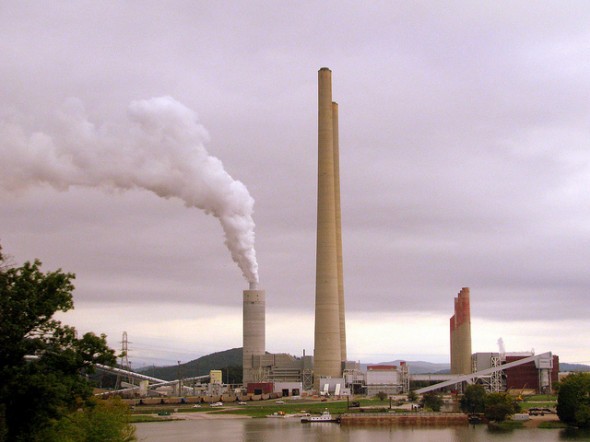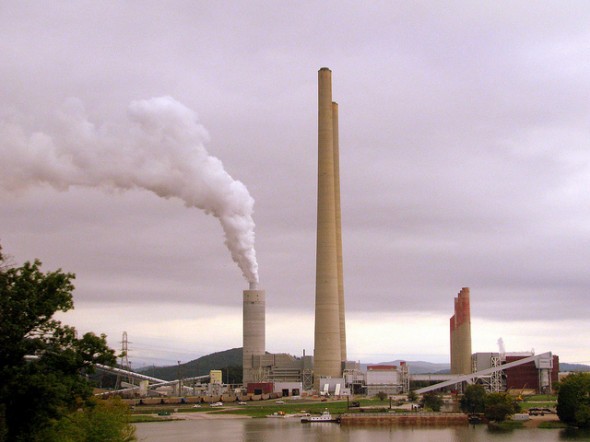Report: U.S. EPA Has Chance to Vastly Reduce Water Pollution from Power Plants
EPA proposes tougher federal wastewater guidelines, while electricity generation turns from coal to gas.

By Codi Yeager-Kozacek
Circle of Blue
The United States Environmental Protection Agency should place stricter controls on pollutants like mercury and arsenic when it publishes new effluent guidelines for steam electric power generating plants next year, according to a report from the Sierra Club. The report—and rules—come at a time when power companies are making decisions to either invest in aging coal plants or turn more of their production over to alternate fuel sources like natural gas and renewables, a shift that heralds its own decrease in polluted wastewater.
Electric power plants are the largest industrial source of toxic pollutants in U.S. surface waters, annually discharging thousands of pounds of substances like lead, mercury, arsenic, phosphorous and nitrogen that are released when the fuel sources are burned, according to the EPA. Discharges from these plants are allowed under federal Clean Water Act permits, which must be updated every five years. While states may impose additional regulations, and power companies can employ a variety of techniques to monitor and prevent water pollution, there are currently no federal limits on the levels of toxic metals in wastewater.
–Tiffany Hartung,
Sierra Club
Proposed EPA guidelines for effluent discharges, published in June, will change that. The guidelines were last updated 31 years ago, and are part of a recent push by the federal government to cut down on water pollution from power plants after a 2008 coal-ash pond failure spilled 4.1 million cubic meters (5.4 million cubic yards) of wet coal ash into communities near Knoxville, Tenn. While a separate coal-ash rule is still pending, the new effluent guidelines could cut the industry’s pollution by 18 to 98 percent annually, depending on the option chosen. They could also cost electric power plants—including nuclear, coal, oil and natural gas-fired plants—between $US 185 million and $US 954 million.
For aging coal plants—most of which are more than 30 years old—the cost of environmental upgrades will play into decisions about plant closures. Coal plant operators already plan to mothball 27 gigawatts of coal-fired power generation—about 8.5 percent—by 2016, according to the U.S. Energy Information Administration (EIA). Some analysts predict it could be more than twice that amount. Much of that generation will be taken up by natural gas, which last year tied coal for providing the largest share of total electricity generation for the first time in history. Natural gas, however, faces its own water use and pollution challenges, and environmental groups are urging the power industry to instead turn to renewable energy sources.
Power Generation and Water Quality Concerns
The Sierra Club report, “Closing the Floodgates,” details the extent of water pollution from coal-fired power plants across the United States. It asserts that these facilities create 5.5 billion pounds of water pollution annually, threatening drinking water, recreation and the health of aquatic ecosystems. The pollution comes from plant discharges that are regulated by permits, as well as leaks and seepage from coal ash storage ponds—many of which do not require linings.
The report also accuses states of failing to enforce the Clean Water Act through the permits they issue for discharges, stating that 70 percent of coal plants do not have limits for arsenic, boron, cadmium, mercury and selenium in their permits. Certain metals can build up to harmful levels in an ecosystem as they move up the food chain—a process known as bioaccumulation. This is of particular concern for communities where fish make up a large portion of residents’ diets. Failure to put limits on these metals therefore puts national resources, like the Great Lakes, in jeopardy, according to the report.
–Erin Culbert,
Duke Energy
“There are a lot of Michigan power plants in that report that do not have limits in the permits for toxics in the water,” Tiffany Hartung, the Sierra Club’s Beyond Coal Campaign representative for Michigan, told Circle of Blue. “Coal plants are big water users—they intake a lot of water, and then output a lot of water, and toxic discharges as well—and there are a lot of them located on the Great Lakes. It’s something to think about.”
Industry leaders, however, say the risks are overstated.
“The idea that any coal plant can discharge an unlimited amount of metals is simply not true,” Erin Culbert, a spokesperson for Duke Energy, told Circle of Blue in an e-mail. Duke Energy, headquartered in Charlotte, N.C., is the largest electric power holding company in the United States. “State regulators continually evaluate plant discharges and re-evaluate discharge permits every five years. Permits do not contain limits on certain constituents when the amount discharged is very low and is not likely to affect water quality in the lake or river.”
Reducing Water Pollution
During combustion, coal creates fine particles, known as coal ash, that contain the metals that can be harmful to air and water quality. Coal ash handling traditionally used water to clean the coal ash from the plant and transport it to storage ponds—a method known as wet ash handling. In recent years, however, environmental concerns and regulations have prompted an industry shift toward dry ash handling. This method uses pneumatic systems to essentially vacuum the ash into containers that are then emptied into dry, lined landfills. Dry ash handling is now used at 66 percent of coal and petroleum coke power plants, according to the Sierra Club report.
“Generally speaking, managing fly ash in a drier form and storing in a lined landfill significantly reduces the volume of ash going to an ash basin, allows you to market it more easily for beneficial reuse and provides added protection to groundwater and surface waters,” Duke Energy’s Culbert said. “It’s also a significant investment that hasn’t been appropriate for every location given our evaluation of a number of factors.”
She explained that the operating lifespan of the units, the plant design, existing technologies, and considerations needed to protect a body of water are all factors that go into decisions about ash handling systems.
–Tiffany Hartung,
Sierra Club
Some of the options being considered in the EPA’s proposed effluent guidelines would require power plants to use dry ash handling for both fly ash—the ash taken out of the air—and bottom ash—the residue left on the bottom or walls of a coal furnace. These options would reduce annual water pollutants produced by the industry by 80 to 98 percent.
Moving Past Coal
The transition to stricter pollution controls is one factor that power plant operators are looking at when deciding to update or discontinue aging coal plants. In the last few years, low natural gas prices have prompted many plant owners to invest in gas-fired plants instead of making the expensive retrofits to coal plants. The EIA estimates that of the 340 gigawatts of new electricity generating capacity to be added between 2012 and 2040, natural gas will account for 63 percent. The typical coal-fired plant withdraws nearly 160 times as much water per megawatt hour as the typical natural gas plant, while water consumption rates per megawatt hour are comparable between the two types of plants, according to data from the Union of Concerned Scientists.
By the end of 2013, Duke Energy will have retired 3.3 gigawatts of coal-fired power with plans to retire nearly 6.8 gigawatts of coal- and oil-fired generation, according to Culbert. The company has a “robust evaluation process” for deciding whether to retrofit a coal plant or retire it, including considerations about its age, design, fuel prices, customer demand, environmental regulations, and compliance requirements, she said. Duke Energy has recently added four new combined-cycle natural gas plants and has a fifth plant underway. Nonetheless, they do not anticipate coal will be going away anytime soon.
“We believe it is important to maintain a diverse fuel portfolio to protect customers from dramatic shifts in fuel prices and provides us more operating options,” Culbert said. “While we are not planning to build any new coal units in the near term, we do expect coal with advanced emissions controls will continue to be part of our generating mix in the future.”
Environmental groups hope that renewables like wind and solar will instead make it into the mix.
“We think it is time to make the transition to more modern and clean energy sources—that being renewables,” said Hartung of the Sierra Club. “They need to be making these decisions now to shift those investments from pollution controls to investments in clean, renewable energy. No one has had an asthma attack from a wind turbine.”
A news correspondent for Circle of Blue based out of Hawaii. She writes The Stream, Circle of Blue’s daily digest of international water news trends. Her interests include food security, ecology and the Great Lakes.
Contact Codi Kozacek









Leave a Reply
Want to join the discussion?Feel free to contribute!